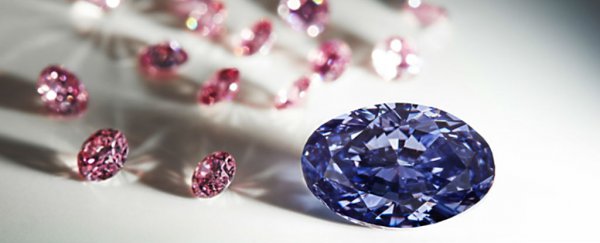If diamonds truly are a girl's best friend - like decades of marketing campaigns would have you to believe - then the Argyle Violet, uncovered recently in Australia's remote Argyle mine, could provide several lifetimes worth of friendship, because this is one of the rarest gems ever found.
Located in the arid East Kimberley region of Western Australia, the Argyle diamond mine provides 90 percent of the world's pink and red diamonds. These colourful gems cost, on average, 50 times more than normal white diamonds, and can sell for about US$1 million per carat, according to the AFP.
The newly found Argyle Violet, which is owned by Australian mining giant, Rio Tinto, weighed in at 9.17 carats when it was pulled from the ground, and has now been crafted down to 2.83 carats.
"Impossibly rare and limited by nature, the Argyle Violet will be highly sought after for its beauty, size and provenance," Rio Tinto Diamonds general manager of sales, Patrick Coppens, told the press. "This stunning violet diamond will capture the imagination of the world's leading collectors and connoisseurs."
So far, only 12 carats of polished stones of this nature have been produced in 32 years, which shows just how rare these violet diamonds are.
White diamonds, on the other hand, which are the most commonly found and sold type of diamond, aren't actually rare at all. According to Tom Zoellner at The Washington Post, the world's diamond market is controlled so heavily by jewellery companies that the iconic gem's scarcity is artificially created to inflate prices. So, you know, keep that in mind the next time you hit the mall.
While this is true for white diamonds, coloured ones are a bit of a different story.
According to diamond analyst Paul Zimnisky, in 2015, over 135 million carats of diamonds were produced, representing a US$14 billion dollar industry. When you compare this figure to the 12 carats of violet diamonds we've seen over the past three decades, you start to get an idea of just how extraordinary the Argyle Violet is.
So how do these colourful diamonds form? Well, scientists aren't entirely sure, but the general consensus is that foreign particles can get mixed up in the crystallisation process, which causes the normally white diamond to change on a molecular level.
In case you were wondering, diamonds form in Earth's crust when carbon atoms bond together under extreme pressure to form crystals. But as of a few years ago, that's not the only way to make a diamond - researchers have figured out how to make 'synthetic' diamonds in an industrial microwave, and they're just as sparkly, but without all the questionable ethics.
The Argyle Violet will be the centrepiece for Rio Tinto's annual showcase, which will travel around to various cities in June 2016.
